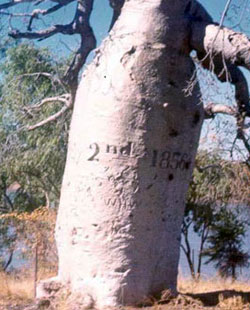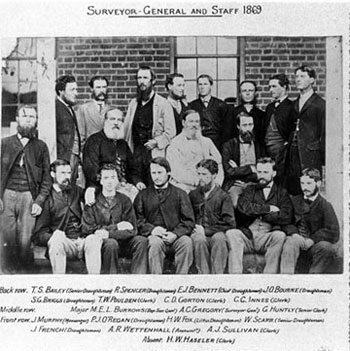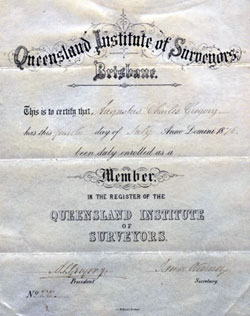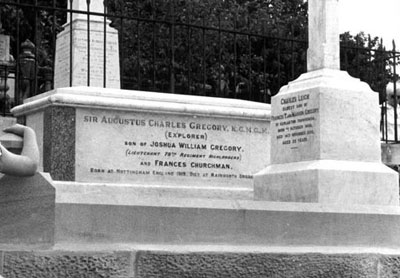Sir Augustus Charles Gregory

Augustus Charles Gregory was born in 1819 in Farnsfield, Nottinghamshire, England. He migrated with his family to Western Australia as a child. He trained as a surveyor and became a noted Australian explorer and doyen of Queensland surveyors.
Involvement in exploration
In 1855 Gregory was appointed leader of the North Australia Exploring Expedition, an ambitious project organised by the British Government, which included the noted botanist Ferdinand Mueller.
In June 1856, after extensive travels in the continent's north-west, the party rode east to the Gulf of Carpentaria. In late September the same year they reached the Gilbert River where Gregory observed a geological structure ‘wholly dissimilar’ to any other part of the north (here gold was later discovered). (Gregory, AC and FT 1884, Journals of Australian Exploration, p. 179) Then retracing the steps of explorer Ludwig Leichhardt, they travelled down the Burdekin River, impressed by the ‘extent of the country suited for squatting purposes.’ (Gregory, AC and FT 1884, Journals of Australian Exploration, p. 188) Continuing south, the expedition reached Brisbane in December 1856. In 16 months they had travelled over 5,000 miles by land and 2,000 miles by sea.

In 1858 Gregory led another expedition, sponsored by the New South Wales Government, to search for traces of explorer Leichhardt. It was one of several such expeditions in the wake of the explorer's disappearance in 1848 on his journey across Australia. On 27 March 1858 Gregory's party set out from Juandah Station on the upper Dawson River and travelled west. On 21 April at the Barcoo River near the future site of Blackall, they found a tree blazed by the missing explorer. Following the stream southward, they were halted by rain in the Channel Country. Gregory later wrote:
‘… had the rain continued the party would have been annihilated, as our camp was between the deep channels which intersected the plain; and in attempting to extricate ourselves … found ourselves so completely entangled among the numerous deep channels and boggy gullies, in some of which the horses narrowly escaped suffocation in the soft mud, that … after three days of severe toil we had scarcely accomplished a distance of five miles.’ (Gregory, AC and FT 1884, Journals of Australian Exploration, pp. 203-4)
Later the party ascended the Thomson River but by mid May 1858 were forced, by drought, to abandon their search for Leichhardt. They turned south to investigate the drainage system of central Australia. Proceeding down the Cooper and Strzelecki creeks, they passed through country so desolate that the horses were reduced to feeding on the thatch of old Aboriginal huts. In June 1858 the intrepid explorers reached the Flinders Ranges and subsequently Adelaide.

Queensland's first Surveyor General
By the time Queensland became a separate colony in 1859, settlement had extended from the Maranoa in the south-west to coastal Capricornia in the north.
On 23 December 1859, Gregory was appointed Queensland’s first Surveyor General and held this post until 11 March 1875. He presided over all land matters in the new colony, as Surveyor General and Chief Commissioner of Crown Land, with the assistance of a small staff of surveyors, land commissioners, draftsmen and clerks. Despite his limited resources, Gregory was responsible for classifying and controlling an area of more than 670,000 square miles, only sparsely populated and of varying physical and climatic conditions.

A skilled surveyor, he attempted to strengthen the involvement of surveyors in land administration, insisting that all land should be surveyed before being opened for selection and advocating the appointment of surveyors as land commissioners. Gregory had a hand in drafting Queensland's early land legislation, which sought to achieve a balance between pastoral interests and the need to develop agriculture.

During his time as Surveyor General, he surveyed part of the Queensland-New South Wales border and in 1882 was appointed to the Legislative Council. Gregory remained active in public life as Chairman of the first Toowong Municipal Council, a leading Freemason, Anglican and member of scientific organisations. From 1876–99 he served as a trustee of the Queensland Museum.
In 1876 Gregory helped establish the Institute of Surveyors and was the foundation President. The Institute was revived in 1899 and Gregory became the first honorary member, in recognition of his achievements as both explorer and surveyor.
Gregory was knighted in 1903 and is honoured in the naming of the Gregory River, the Gregory North and South pastoral districts and the Gregory Highway, all in inland Queensland. On 25 June 1905 Gregory passed away at his home, Rainworth, and was buried in the Toowong Cemetery.


